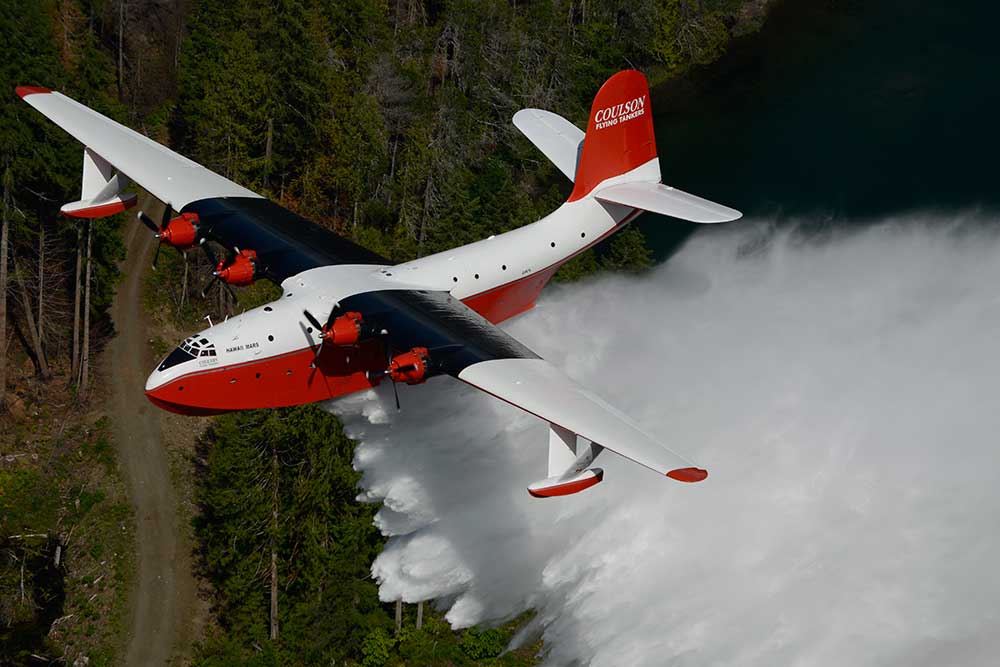VICTORIA INTERNATIONAL AIRPORT: The BC Aviation Museum is thrilled to officially receive the news that the Honorable Lana Popham, BC Minister of Tourism, Arts, Culture and Sport, announced the BC government’s special grant of $250,000 towards the museum’s efforts to rescue the Hawaii Martin Mars water bomber as a brand new public attraction at the Victoria Airport.
Representatives from the aircraft’s donor Coulson Aviation and the Museum’s Save the Mars Team joined Minister Popham for the announcement this afternoon in front of the Mars at the Coulson Tanker water bomber base, located at Sproat Lake near Port Alberni on Vancouver Island.
 The red and white Hawaii Mars flying boat, being equal in size to a huge Boeing 747 airliner, is probably the most famous aircraft in BC aviation since it successfully fought wildfires for five decades before retiring in 2015.
The red and white Hawaii Mars flying boat, being equal in size to a huge Boeing 747 airliner, is probably the most famous aircraft in BC aviation since it successfully fought wildfires for five decades before retiring in 2015.
Coulson Aviation will begin a several-month process preparing the aircraft for its final flight in the autumn of this year.
“While it will be a monumental project just to get it here, it will be one big jewel in our crown,” said Steve Nichol, President of the B.C. Aviation Museum. “The Hawaii Mars has real historical and cultural value, therefore the museum plans to make it the centerpiece of our B.C. Wildfire Aviation Exhibit, of which we already display many amazing aircraft. And there are future plans to build our third interactive hangar to house these new attractions.”
For the Save the Mars Team project lead Richard Mosdell, the Mars has also been his favorite aircraft. “I was lucky to witness many demonstration practice drops when I swam at the lake often as a kid, and then later I knew of its extensive use when I was in forest firefighting, but eventually when working for its previous owner MacMillan Bloedel I had this great job to take Japanese lumber buyers on tours of the Mars which included translating all the amazing stories from the flight engineers and pilots.”
“Now after these past two years of discussions with the donor, Heritage Canada and numerous stakeholders, and with the consistent help of the museum’s fantastically dedicated volunteers and staff, this huge rescue puzzle is finally being solved so that everyone can hear these same stories and even sit way up in the cockpit of this iconic aircraft.
“And Vancouver Islanders are in for an amazing aerial treat because the Mars arrival is going to be like a big blockbuster movie weekend as everyone from Nanaimo to Victoria will get to watch the massive, majestic Hawaii fly low and slow overhead with its immense 200-foot wingspan and wonderfully loud radial engines.”
The rescue flight will end with the Mars smoothly landing on the ocean at Pat Bay beside the Victoria Airport, followed by it being pulled up onto the Coast Guard base near the still standing World War Two hangars where it was originally converted into a water bomber, before its slow careful move to the museum.
Everyone interested in contributing to the Save the Mars campaign is warmly welcome to go through the donation service on the museum’s website since the rescue is incredibly costly due to this vintage aircraft requiring hundreds of hours of precise servicing before this flight, and many hours after to properly prepare for visitor’s having a really special experience.
And starting from today, the YouTube channel for the BC Aviation Museum will begin a new playlist of Mars preparation and flight videos so everyone can follow along with its progress.
The museum kindly thanks the many stakeholders who have expressed their support,
including the BC provincial government, Victoria Airport Authority, Destination Greater Victoria and Heritage Canada.
Future plans are for building the museum’s third and much larger hangar to not only
properly display the Mars, the BC Wildfire Aviation exhibit and other incredible aircraft, but to offer more interactive and educational experiences, including flight simulators where guests experience for themselves flying the Mars on waterbombing runs.
BACKGROUND: The Hawaii Mars flew from 1961 to 2015 around North America fighting over 4000 wildfires with its massive water dropping ability that could end a huge blaze in a single pass. These enormous red and white aircraft captured the hearts of British Columbians for how they saved BC forests.
Originally several Mars were built by the US Navy during World War 2 to transport troops across the Pacific. In 1960 they were brought to Canada for a radical conversion to become waterbombers. They went on to be based at Sproat Lake, BC for 6 decades.
After the current owners, Coulson Aviation, retired their Mars fleet several years ago, the BC Aviation Museum began discussions with the owners, the intention being for the iconic Mars to become the signature display.
The BC Aviation Museum celebrates the past, present and future of BC Aviation with one of the largest aviation collections in Canada. Visitors of all ages will be amazed by our interactive experiences. Come and learn about BC’s incredible aviation stories.

